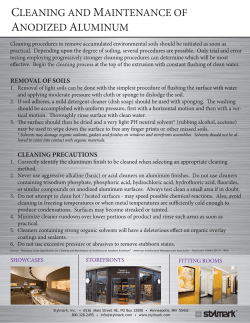
High pressure cleaning on farms How to avoid injuries! 1
High pressure cleaning on farms 1 High pressure cleaning on farms How to avoid injuries! 2 High pressure cleaning on farms preface The Danish Industry Working Environment Council, Farm to Fork is publisher of this guide to high pressure cleaning on farms. The guide describes a row of practical solutions to increase safety during manual work with high pressure cleaners. The Danish Industry Working Environment Council, Farm to Fork, consists of representatives from the parties of the labour market and has been established according to the law on working environment. One of the Council’s responsibilities is to inform and instruct about working environment conditions. The Danish Industry Working Environment Council, Farm to Fork, has formed the permanent committee Agriculture’s Working Environment Committee. This committee deals with the working envi-ronment within the areas of agriculture, forestry, horticulture and landscape gardening. The committee’s composition, objectives and tasks can be found on the Danish Industry Working Environment Council, Farm to Fork’s website: www.barjordtilbord.dk. This guide has been prepared by the Danish Industry Working Environment Council, Farm to Fork, in cooperation with Knowledge Centre for Agriculture. The Danish Working Environment Authority has read through this instruction and finds it in compliance with the law on working environment. The Danish Working Environment Authority has evaluated the instruction as it is, and has not dealt with whether it covers all relevant subjects within the various areas. We make reservations for the technological development. For the Danish Industry Working Environment Council Vagn Henriksen, Fagligt Fælles Forbund, 3F Johnny Ulff Larsen, Gartneri-, Land- og Skovbrugets Arbejdsgivere, GLS-A This guide is a direct translation of the Danish version. Colophon Publisher: Text and layout: Print: Edition: ISBN: Product code: Danish Industry Working Environment Council Knowledge Centre for Agriculture GP Print, Grenaa 1 edition, March 2011 978-87-910-73-65-6 14 20 66 High pressure cleaning on farms 3 If it has to be clean … There is no way around manual high pressure cleaning when livestock housing, silos, machines and platforms are to be cleaned thoroughly. It is a demanding task. The working positions stress your hands, arms and shoulders. Skin and bones are affected by cold, blows and falls. Eyes and respiratory system are subjected to small particles that are whirled about. And your hearing is endangered by the high noise level. These factors make it even more important to approach this work with all practical precautions and the correct personal protective equipment available. Studies show that most people working with high pressure cleaners feel one or more physical effects of the work and that they find defects in the equipment. Illegalities like the following can be found as well: • The handle is blocked with strips • Young people under 18 work unsupervised • Breathing masks or eye protection is not used • Other kinds of personal protective equipment is not used Yearly the Danish Working Environment Authority receives more than 200 reports on work related injuries within farming of which the top 4 are reduced hearing, injuries to the motor apparatus, skin diseases and respiratory diseases – all injuries that are typically caused by high pressure cleaning. In this guide you will find a row of practical solutions for increasing safety while high pressure cleaning – in the form of better working methods and using the appropriate personal protective equipment. Don’t jam the handle of the high pressure cleaner with strips – the machine can start without being activated. 4 High pressure cleaning on farms High pressure cleaning – dangers and protection Hearing in danger Bull’s eye A high pressure cleaner makes a lot of noise and loss hearing will come creeping up on you. When you are exposed to 97 dB(A) for more that 10 minutes a day you risk reduced hearing. You must wear ear protectors right from the start of your work. Choose a kind that effectively dampens high frequency noise. The ear protector must fit tightly to the ears. A high pressure cleaner whirls dirt into the air and aerosols are formed that go into your eyes and irritate – or in the worst case – injure them. If you use earmuffs you must be aware that glasses, hair and cap can keep prevent a tight fit. This diminishes the effect. Ear protectors must be maintained and the sound dampening material in the earmuffs must be changed regularly in order to provide full protection. Some ear protectors dampen noise in all frequency areas and still make it possible to hear what is said, to hear signals etc. Some of them are equipped with radio or a plug for an mp3 player. Ear protectors must be used as long as the high pressure cleaner is used. Even small periods of time can affect your hearing dramatically. At a sound frequency of 2.000 Hz the effective dampening will be reduced from ca. 40 dB(A) to ca. 20 dB(A), if the ear protectors are only used for 99 % of the time. Duration of use Always use goggles or a full mask. The best solution is a turbo breathing mask with a detachable screen. The screen will get dirty while you work, but it can be cleaned with a couple of pumps from a spray bottle. The screen can be changed during breaks. High pressure cleaning requires more light (minimum 200 LUX) that the light level needed for supervising livestock. Eye protection must be used when you work with cleaning agents or disinfectants. Aerosols are tiny bits of solid matter like bacteria, fungus, chemicals, dust from plants and animals, mites, soil, and rust. All encapsulated in microscopic drops of water. The water makes them go deeper into the lungs than they would have done as dry matter. Breathing under attack 100 % 99 % 98 % 95 % 90 % Effective dampening, dB 40 20 17 13 9 Dust and aerosols hang in the air – up to one and half hours after the high pressure cleaner has been turned off. Aerosols go straight into your respiratory system and with their content of proteins and micro organisms from manure, feedstuff, livestock and soil they can cause a row of more or less disabling diseases: toxic alveolitis, asthma and allergic alveolitis, as well as various chronic respiratory diseases. You don’t feel the damage at once. But your lung function is diminished fast, see figure 1. High pressure cleaning on farms 5 With the last two types you have to draw air in through the mask yourself. This is tiring and if the work lasts for more than three hours you must use the first possibility from the start – turbo breathing masks. In a turbo breathing mask a battery driven ventilator sucks in the air for you and blows it through the filters to your mask, screen, hood or helmet. Lung function lungefunktion Problem line problemgrænse ca.ca. 3030yrs. år ca. 5555yrs. f.eks. år ca. 8080 yrs. f.eks. år The black line shows the development of a person’s lung function through his lifetime. The lung function peaks around the age of 30 and decreases gradually from there. If a person is exposed to dust, aerosols, and smoke for instance from the age of 18 to 30, the lung function will never be as high (red line) as if the exposure had never taken place (black line). If the amount of dust, aerosols, etc. is reduced for instance at the age of 38 the loss of lung function will change to a milder course (grey line) towards the problem margin for breathing difficulties. If you clean for more than three hours per day you must use a turbo breathing mask from the beginning. With the turbo unit placed above the small of your back the face mask will be comfortable to wear. If you clean for less than three hours a day a filter of the type P3SL and a face mask will be adequate protection. In order not to inhale aerosols you need a filtrating breathing mask. These come in three versions: 1. Turbo breathing masks 2. Full and partial masks with exchangeable filters 3. Filtrating breathing masks with fixed filters (disposable) A breathing mask will only protect you if it is equipped with the right filter, if the mask is maintained correctly and if you use it for the full duration of the work – including one and a half hours after the work has stopped if you are still in the room you have cleaned. Due to risk of infection with salmonella, MRSA, H1N1 or Q-fever P3SL or FFP3SL filters must be used during high pres-sure cleaning of livestock housing. While cleaning livestock housing the breathing mask must be equipped with a P3SL filter or a FFP3SL filter. The requirements during laying out cleaning agents or disinfectants can be found on the chemical’s packing or in the supplier’s instructions for use. 6 High pressure cleaning on farms Falling on your feet While using a high pressure cleaner you move around on slippery surfaces. And sometimes you must move around like an acrobat in narrow rooms while stepping over shackles, grids and gates. The danger of falling and being injured is imminent. Livestock housing should be designed to facilitate cleaning. Always use slip proof rubber boots so that you won’t fall or be injured by the jet of water. Shoulders/arms – wear and tear A high pressure cleaner will give repercussions and the vibrations are transmitted to the person operating the high pressure cleaner. The blow and the vibrations stress the shoulder and arm carrying the jet handle. If the lance is equipped with an angle the other arm and shoulder will be stressed as well. You can counteract this in various ways: • Support the lance with your body most of the time. • Move your legs instead of turning your body. • Change the position of your fingers, arms and body many times during the work. • Only hold your joints in a stretched position for a few seconds at the time (for instance a stretched arm). • Vary the water pressure. • Change between holding the lance with your right and your left hand. • Let go of the handle for a few seconds while walking from one pen to the other to give your muscles a break. • Choose a lance length that suits your height. • Change the lance so that its weight and angle suits the object you are cleaning. • Wrap the hose around your upper body so that the hose is pulled by your body when you move around. Locking handles with strips is lunacy. It can easily lead to your being “shot” through your hands or feet or provide you with a serious eye injury. Support the elbow of the arm with which you steer the lance (here it is the right arm). Your shoulder and elbow joints will be least stressed in that way. If your elbow is moved as little as 30 cm from your body the stress on your shoulder and elbow joints will be doubled. Likewise, the load can be minimised by: • Organising the work in a way that ensures that soaking and a rough cleaning is performed. • Taking small breaks and using job rotation during larger tasks. • Maintaining the equipment in an optimal way. Bad maintenance of technical aids may increase vibrations and noise. High pressure cleaning on farms 7 The body – cold, draught and moisture Rooms that are to be cleaned with a high pressure cleaner should be aired as much as possible – on cold winter days as well. This makes for a cold working environment, often with draughts as well. And the water from the high pressure cleaner cannot but make the job a wet business. Use working positions that create straight lines in your body and limbs (especially avoid bending and twisting your back). Make sure that shoulders, knees, and wrists are in a “middle position” – i.e. neither bent nor stretched. Choose rainwear and gloves that can resist the pressure from the high pressure cleaner you are operating. Apart from this clothing and gloves must live up to a line of requirements: • The rainwear must be wind and water tight, but still your body must be able to breathe during the hard physical la-bour • The rainwear must be big enough to make room for warm clothing underneath on cold days • The rainwear must be light, elastic and comfortable, but still resistant to tear and wear • It must protect against heat as well if water warmer than 40°C is used. • The gloves must protect effectively against vibrations, chemicals, cold/heat and cuts. Appropriate working clothes are always necessary for wet work. The rain trousers must be wide enough to go over the bootlegs to prevent the lance getting stuck in the bootleg. The operators of high pressure cleaners have different heights. Purchase lances with different lengths. A good distance between your feet balances your body. Make sure that you distribute the weight of your body and of the equipment equally to both legs. Move your legs often so you won’t twist your back. Make sure that the trouser legs cover the bootlegs to prevent the lance with hot water and a pressure of 160 bar from getting stuck in the bootleg. 8 High pressure cleaning on farms Safety! the responsibility of the employer as well as the employee The employer must purchase and maintain personal protective equipment for the employees. The employer must instruct the employees in the use of the personal protective equipment and he must control that the employees actually use the equipment. Cleaning houses for broilers. The personal protective equipment must be appropriate for the task in hand and it must fit the individual employees. The protective equipment is personal. The employee must use all necessary personal protective equipment – and use them for the full duration of the task. If the equipment is defective he/she must inform the employer. High pressure cleaning on farms 9 The ABC of cleaning High pressure cleaning is used in many different connections on farms. That is why there are different instructions for cleaning. The following recommendations are valid for all forms of use: • Make sure that there is enough light to see the dirt. • Good drains remove washing water and dirt quickly. • Spend time on the rough cleaning in order to ensure that as little as possible of the dirt is sent right back at you while high pressure cleaning. • Ensure thorough soaking to make the time spent high pressure cleaning as short as possible. High pressure cleaning and the WPA and WPI High pressure cleaning must be included in the WPA (Work Place Assessment). Describe for instance how new employees and young people below the age of 18 must be instructed,(no one under the age of 16 are allowed to work with a pressure over 70 bar), how many breaks are needed, how to avoid danger etc. Use of cleaning agents and disinfectants must be described in the WPI (Work Place Instructions). Cleaning livestock housing Begin with cleaning with a shovel, a broom or and industrial vacuum cleaner to remove the worst of the dirt. Foto: Jens Tønnesen, LandbrugsMedierne Then soak with a soaker, a sprinkler or a garden hose. Turn off the ventilation during soaking. Remove dirt from the corners of livestock housing before you start the high pressure cleaner. Otherwise it comes straight back at you. Begin with a rough cleaning in order to remove the worst of the dirt before you start the high pressure cleaner. Water temperature It is unpleasant to clean with cold water, but be aware that water temperatures over 50° C make the dirt cake. The cold water cleaner can – through a heat exchanger – be connected to a furnace which gives a pleasant water temperature of circa 30° C. Air temperature and ventilation Lower the room temperature on the control unit in order to achieve maximum ventilation – that helps to remove aerosols. 10 High pressure cleaning on farms Foto: Jens Tønnesen, LandbrugsMedierne Cleaning milking rooms A hose with automatic roll-up eases the work, because the hose does not lie about on the floor when not in use. An automatic washing system can be installed on a rotolactor and in milking parlours for use during milking and for daily cleaning. In order to achieve the best result you must make sure that the jets are placed correctly and be aware that there is a limit to how much manure and feed residue the system can handle. Stuck dirt is easier removed with a tilted jet. Foto: Jens Tønnesen, LandbrugsMedierne Handling the water jet Stuck dirt is most easily removed with a tilted jet. A tilted jet creates fewer aerosols. Vary the water pressure and water amount according to need. High pressure makes the cleaning time shorter, but it is harder on your body and it makes more noise. Order of cleaning When rough cleaning as well as during the following fine cleaning, the building and equipment must be cleaned in the following order: Floors – walls – equipment – water bowls, valves and pipes – ventilation. Then the floor is washed for the second time and the sludge scraped and removed. A roll up for the hose makes it easier to handle the hose. Laying out soap Soap is best laid out with a so-called foam lance. Soap and other chemicals must never be spread under high pressure as they might etch skin and lungs. When purchasing soap try to choose those kinds that are least damaging to your health. Daily cleaning It is easier to maintain a high level of hygiene if you wash after each milking. That will prevent manure feed and milk residue from sticking to equipment, milking machines and floors. Use a shovel or a broom to remove everything that can be scraped away so there won’t be whirled too much dirt about during the cleaning later. Disinfection Disinfection is a special discipline demanding special knowledge and behaviour. If you use chemicals with a danger symbol on the packing you must have a work place instruction (WPI). This must safety data for all chemicals used, information about personal protection equipment, rules for handling and storage, as well as where to find the first aid box. It can be a good idea to use a hose with low pressure and much water, for instance 5,5 bar and 65 litres per minute. Avoid high pressure cleaning because of the many aerosols. The many fine particles of manure, feed, and milk attach themselves everywhere on Foto: Jens Tønnesen, LandbrugsMedierne High pressure cleaning on farms Daily cleaning of milking parlours is done best with a hose and a roll up for the hose. all equipment after use for up to one and a half hours after washing. And, of course, they get into your lungs. Periodic cleaning At periodic cleanings – weekly or every second week – walls and equipment should be soaked for 20-60 minutes with a foaming agent before cleaning. 11 Cleaning a liquid feed tank A liquid feed tank can contain too little oxygen, too many fungi toxins, and the mixer might start. That is why the power must be turned off on the main switch or the plug must be pulled out and a warning sign placed so others know why the plug is disconnected. Let a compressor supply the tank with oxygen before and during your work in the tank. There must be another person stationed right outside the tank to call for and provide help if you begin not to feel well. Consider a safety line. A liquid feed tank must be cleaned on the inside once a week to remove feed residue, mould fungus, and the like on surfaces not covered during the mixing of the liquid feed. The feed inlet to the tank must be cleaned every second week in order to remove possible “cakes” (wet feed residue). Here you must: • control the built-in washing system • change leaking gaskets/membranes • empty the stone collector For cleaning the liquid feed tank you should use low pressure clean-ing – under 70 bar – with a large amount of water from a 10-20 cm lance since the inside of the tank is smooth. A hose with low pressure and a large amount of water works well for soaking and sluicing. Må ikke startes When high pressure cleaning a liquid feed tank you must always turn off the power on the main switch. Place a warning sign so others can see that work is being done on the machine. 12 High pressure cleaning on farms Cleaning tractors and machines Start by removing residue of grass, dirt etc. Then cover up vulnerable parts, if they are not covered already. Then they won’t be de-stroyed by the water pressure. Soak parts that are hard to reach or very dirty. Rainy days are good washing days. Not all dirt is equally stuck. You can use that to vary the water pressure and achieve a much needed variation in your muscle work. Change lance and jet during cleaning. Machines that often get dirty from cut grass or road salt can be greased with a mixture of hydraulic oil and diesel. The dirt will be less stuck next time. Remember to use personal protective equipment. Especially for slurry wagons It is only necessary to wash slurry wagons inside after taking slurry from a herd under public supervision for salmonella or other infectious diseases. Normally it is enough to sluice the slurry wagon inside shortly after use so the slurry won’t have time to dry. You can sluice the wagon by filling it with water and spreading the load in the ordinary way. If you use a soaking agent and let it soak for 20 minutes, it reduces the time you need to spend high pressure cleaning. Start from the top of the machine. The water temperature should be around 40°C. That helps to remove greasy coatings of oil, traffic film and plant juices. The combined eye- and breathing protection does not protect against slurry gasses, but against aerosols in the lungs and particles in the eyes. Because of the danger of hydrogen sulphide poisoning you must never crawl into the slurry wagon. Hydrogen sulphide is so dangerous that your breathing will be paralysed after one or two breaths. Even in small doses your sense of smell will be paralysed so you won’t detect the danger. If you want to check on the result of the cleaning you should do so by looking through the manhole in the side of the wagon. The man-hole at the end of the slurry wagon must be kept open to ensure free passage of air. Build a cleaning platform for cleaning machines. It makes it possible to work in good and safe positions. High pressure cleaning on farms 13 Cleaning pelting centres A good workflow and minimal cleaning work can be achieved by: • Removing all discarded material within the mink fence or just outside. • Checking if cages, nesting boxes, celutex or masonite plates can be cleaned sufficiently or if they should be changed. • Removing all manure and straw, including that in the lanes. • The soil must be treated with hydration lime or natriumhydroxide. Residue of fur on mink cages is best removed with a turbo jet. If the roof plates are of asbestos type they must not be high pressure cleaned. Sluicing is normally enough to remove cobwebs and fur. Remember that equipment and vehicles within the area must be cleaned as well. The soil/floor of a mink house can be disinfected with hydration lime. Cleaning starts with: Soaking for at least 20 minutes in water added with a basic cleaning agent that foams. Wash within an hour. When soaking at below zero temperatures add anti freeze. Remember to use personal protective equipment. Use the high pressure cleaner from the top and down. Use a hot water cleaner, max 50°C, when cleaning during the winter months. A turbo jet facilitates the work of removing fur from the cages. Short jets of about 10 cm can be used with advantage for cleaning places that are hard to reach. Vary the pressure so that cages and slurry channels are washed with more pressure than nesting boxes. Finally you wash the ceiling and woodwork to remove loose and wet dirt. Check the results when nesting boxes and cages are dry and con-sider the need for extra cleaning. When sanitising the cleaning must be approved by a vet before you disinfect. Farms that have been hit by plasmacytosis are placed under public supervision. This includes cleaning and disinfection. The farm must be disinfected twice with at least one week in between. Cleaning and disinfection must be approved by the regional veterinary and food administration. The disinfectant used must be documented, as well as the outside temperature on the day it was done, how it was done, and the names of the persons who carried out the work. Soil disinfected with lime after cleaning. 14 High pressure cleaning on farms BUILD your way to easier cleaning If you are going to renovate or build new livestock housing you have the possibility of building easier cleaning into your future system. You can do this through: • A back plate in parallel milking parlours prevents the cows from letting manure into the milking lane. • Automatic roll-up for hoses eases the work since the hose will not lie loose on the floor. Choose smooth surfaces Apart from this, cleaning can be made easier and more effective by as often as possible choosing materials with smooth surfaces on floors and equipment. Dirt can be removed easier and with a lower water pressure. Plastic, steel, flat bars and surface treated concrete are such cleaning friendly materials. Details with effect Stationary compressors should be placed in a sound proofed room with an air exhauster. This causes less noise. • Stationary compressors, to supply the individual washing sites. The advantage is less noise because the compressor can be placed in a closed room. • Ample water pipes, that can transport large amounts of water – prepare for later extensions. • Soaking systems in two parts (for pig housing): 1) A piping system over the living areas where the jets change between shower jets and 360 degrees soaking jets. 2) A piping system over the rest areas with 360 degrees soaking jets so feed and water pipes can be cleaned, too. • LED-lighting with variable light intensity or light in two net-works where one is for daily / normal use and the other with bright light for cleaning. Fluorescent tubes and motors for ventilation must be water tight. • Prevention of blind angles to keep you from holding too many stretched positions and to minimize the need for manual cleaning after the washing robot has finished. • Sluicing systems (are integrated in some rotolactors and milking parlours). Finally a line of simple details can help to remove what prevents easy and effective cleaning: • Pipe ends must be closed. • Gate handles must be made of smooth metal • Threads must not poke out. • Foundations under mangers must be even – mangers without foundations force the cleaner to crawl. • Blind corners must have smooth transitions in order to limit back spray. • Side strengtheners can be made of flat bars with smooth surfaces. A stationary high pressure cleaner makes washing easier. High pressure cleaning on farms 15 Before you buy a high pressure cleaner You can save money through a few simple considerations before you buy a high pressure cleaner. Ask yourself the following questions: 1. Can the time you now spend on high pressure cleaning be spent better on other work? - Maybe it pays to let professionals take care of the big cleaning tasks, so that you will only have to take care of the smaller ones. 3. Could exchanging and buying new accessories (gun/lance/jets) be put instead of buying a new high pressure cleaner? - Technical developments in this area has been concentrated on the accessories and new technical developments that can be used with your existing high pressure cleaner could be a good idea if the high pressure cleaner basically works well. 2. Would it be financially wise to invest in a cleaning robot? - Cost accounting for this investment can be found – and the robot might be shared with another farmer. 4. Would a longer hose with perhaps a different diameter and turn clutch ease the work? - A longer hose gives the cleaner a bigger radius. The diameter can be adjusted to prevent the hose from getting stuck on the slats. Turn clutches prevent the hose from curling up. This handle does not require much finger pressure to activate the high pressure cleaner. This relieves the muscles of the lower arm. It can be used with other brands. Note the short lance that makes it possible to clean in narrow places. There are various kinds of accessories on the market adapted to various cleaning tasks. The result is better comfort. 16 High pressure cleaning on farms When you buy a high pressure cleaner As owner of a high pressure cleaner you have the responsibility for how it is used – this includes the accessories. This means that you must: • Make sure that the right type of high pressure cleaner and accessories are used for the task in hand. • Make sure that the high pressure cleaner is used correctly. • Maintain the equipment in order to make sure that it is always safe to use, clean and repair. You can take on this responsibility check the following in connection with the purchase: • Is the high pressure cleaner CE-marked? • Do the instructions show the uses the high pressure cleaner is constructed for and which it is not constructed for? • Do the instructions inform about all risks and are there any instructions for how to avoid these? • Are the instructions sufficient: correct assembling, installation, start procedure, use, adjusting, cleaning, maintenance and repair? • Do they include data on noise and vibrations in relation to marginal values? • Are the instructions in Danish? • Are all warning signs visible and easy to understand? Apart from a “yes” to these questions you should make the supplier demonstrate how all safety precautions work. If you find a breach in safety you must inform the supplier fast. Perform an unbiased study of the high pressure cleaners on the market before you decide. Don’t let your heart or your purse make the choice for you. Prioritize safety and comfort. High pressure cleaning on farms 17 Comparison between the working environment factors of different high pressure cleaners An example Company: Model: Company: Model: Company: Model: Max pressure, bar. 200 bar Max amount of water per minute 40 l pr. minute Is the water led directly to the lance or through the pistol? Directly to the lance The motor rotations are increased gradually so the recoil is low from the out start? Yes Variable adjustment of the amount of water on the lance? Yes Variable adjustment of the work pressure on the lance? Yes Chemicals are only absorbed in low pressure mode? Yes Can extra and varied lances be purchased? Yes, different lengths, angles, single and double Is the gun pressure relieved so the safety clutch is easy to hold? Yes Is a heat exchanger included in order to ensure that washing at 30°C can take place? Yes Can special lances for cleaning feed pipes, ceilings and ventilation be purchased? Yes – for pipes Is the protective shield (handle and 1-2 m hose) effective at the pressure level where the work takes place Yes The size of the high pressure cleaner – can it get through doors and corridors? Yes Other important factors The company provides a good service Price excluding VAT 18 High pressure cleaning on farms More knowledge www.agrinoise.com This guide has been written on the basis of tests, surveys and Dan-ish legislation High pressure cleaning on farms 19 20 High pressure cleaning on farms Danish Industry Working Environment Council Agro Food Park 15 DK-8200 Aarhus N Mail: barjordtilbord@jordbruget.dk Tel.: +45 87 40 34 00 The Employee Secretariat Kampmannsgade 4 DK-1790 Copenhagen V Mail: barjordtilbord@3F.DK Tel.: +45 88 92 09 91 www.barjordtilbord.dk
© Copyright 2025









